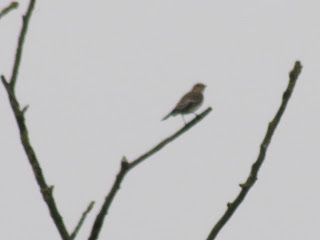David Bilcock flushed a WRYNECK from one of the tracks on Top Scrub, Ivinghoe Hills, late morning and after a brief search, he relocated it perched high in a Hawthorn. It remained on view for about 35 minutes, allowing both Mike Campbell and Francis Buckle to connect (see pictures), but then flew into dense cover and disappeared. Several more people then arrived but despite searching, it could not be relocated. Dave also saw TREE PIPIT, 4 COMMON REDSTARTS and a WHINCHAT during a comprehensive sweep of the area.
At the time, I was in East Kent, but on returning late afternoon, I grilled
David on exactly where he had first seen it, knowing how site faithful Wrynecks
are. After getting the lowdown on the bird, I relocated it within a few minutes
of arriving on site. The bird was favouring a particular anthill and judging by
the amount of droppings, it had been present for at least a few days.
Frustratingly, it was not possible to view the bird feeding without flushing it,
due to the nature of the vegetation surrounding the anthill. I saw the bird on
at least 9 occasions in the two hours I was present, it still being in the area
at 1700 hours. JT, Jeff Bailey, Lucy Flower and around 6 other observers also
connected.
DIRECTIONS
Park in the main Ivinghoe Beacon car park and cross the road into Top
Scrub. Continue as if walking towards Inkombe Hole but before reaching the main
footpath, turn right 40 yards before at the first cross tracks. Continue down
this ride for 80 yards until you reach the clearings on both sides and 4-5
obvious anthills on the edges of the footpath. A track then leads off to the
left for 25 yards and peters out just before the thick scrub. The anthill the
Wryneck is favouring is at the end of this but as you approach, it flies up into
the gorse or adjacent Hawthorn bush. It did this repeatedly every ten minutes.




































































